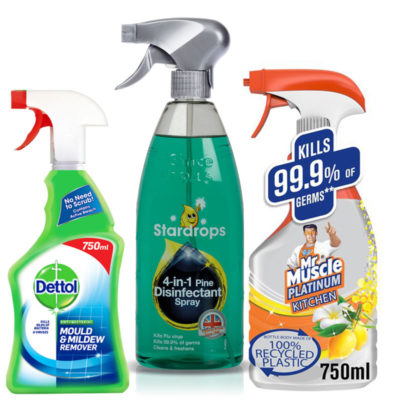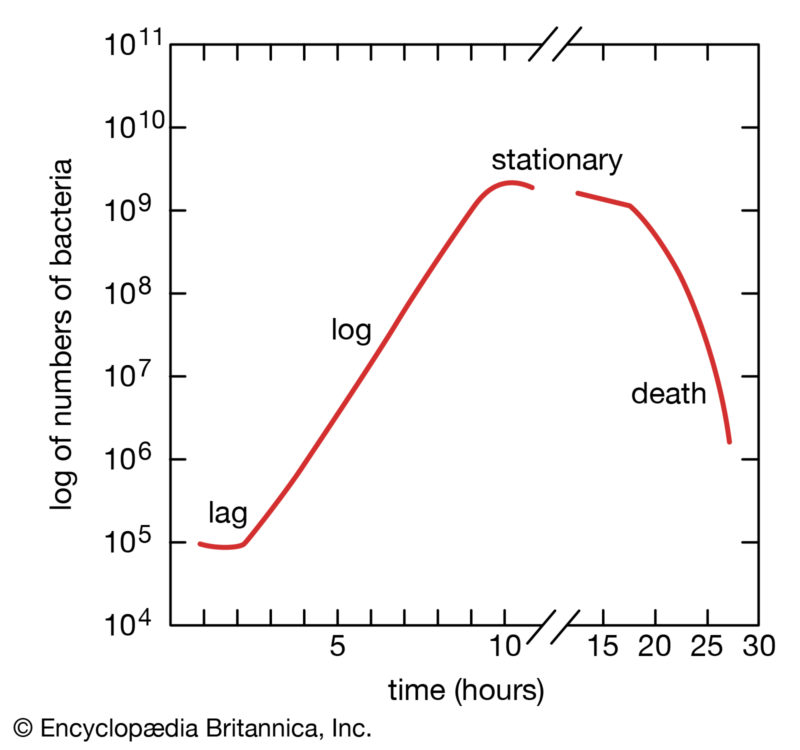
08 Jun Part 1: What Don’t You Know About Bacteria?
Browse any supermarket line of kitchen and bathroom cleaners and you will notice a common theme in their marketing – “kills 99.9% of bacteria”, usually followed by an asterisk exclaiming that the product will kill up to 99.9% if used exactly as dictated under ideal conditions. You may even see what appears to be even better, “kills 99.99% of bacteria”, and you think to yourself, why don’t they just round it up to 100%, it’s very close to 100%, what will 0.01% make a difference? Or is this all just marketing hype?

To understand this, we need to look into two aspects that put these percentages into some context, these are:
- Part 1: The life cycle of bacteria, including the growth and size of bacterial populations
- Part 2: Reduction of bacteria using biocides (sanitisers and disinfectants)
These two aspects will be looked at over two articles, starting with the life cycle of bacteria and then looking at reducing the bacterial population with biocides.
Before we start, you will notice that viruses are not mentioned – viruses do not grow outside of the cells they infect. They can remain viable on surfaces, ready to be picked up by another person and infect that person, but they do not grow into colonies. It’s even debatable whether viruses are ‘alive’.
The Life Cycle of Bacteria
Picture a kitchen worktop or a door handle computer keyboard, any surface that you touch or handle, now imagine a small number of bacteria cells being transferred to that surface from someone’s hand. Bacteria are sensitive to the environment it is in, the temperature, moisture content and nutrient and oxygen content have to be within boundaries in order to support the growth of the bacteria. Our hands (and skin to be more exact) provide the perfect environment for bacteria, they are warm, moist and the oils and dirt provide nutrients for growth.

1 – Lag Phase
The bacteria that were on the hands of someone, transfers some bacterial cells to the surface. This new surface presents a different environment to the bacteria, it will likely be colder and drier. As the bacteria senses this new environment, they undergo a four phase cycle of growth. The bacteria in this new environment do not immediately reproduce. During this phase, called the lag phase, the cells are active and adjusting to the new environment. They are creating enzymes, amino acids and vitamins needed for cell division. The length of this phase is dependent on whether the environment can supply enough nutrients to support growth. i.e. a dirty surface will present a ready supply of nutrients to enable bacteria to quickly move to the log phase.
2 – Log Phase
After the initial lag phase, the bacteria, now ready to start, undergo rapid multiplication. This second phase, called log phase, the bacteria divide and the numbers grow exponentially. This means that every cell divide into two cells, these two cells divide into four cells, each of those fours divide again creating 16 cells, and so on. The time it takes cells to double in number is called the generation time and it depends on the bacterial species and heavily on the environmental conditions.
The generation time (doubling time) for some common bacteria:
- Clostridium perfringens (food poisoning bacteria), one of the fastest-growing bacteria, has a generation time of about 10 minutes
- E. coli can double every 15-20 minutes
- Salmonella can double every 25 minutes
- Staphylococcus can double every 27-30 minutes
- Mycobacterium tuberculosis has a generation time in the range of 12 to 16 hours.
Let’s put this into perspective, take one E.coli cell and under ideal conditions that cell can divide into two after 20 minutes, after another 20 minutes (now 40 minutes from the start) that single cell is now 4 cells. After the first hour the number of cells (after 3 generations) is 16 cells. Now, imagine a kitchen worktop that was used to prepare raw chicken for dinner at around 6pm. The worktop is now contaminated with E.coli and the cleaning has not been as thorough as it should. The next morning at around 8am, the worktop is used to prepare breakfast. How many generations have passed from 6pm to 8 am? There are 3 generations per hour and 14 hours have passed, therefore there has been 42 generations (3 x 14). Under ideal conditions, that one cell has created 4.4 trillion cells, or 4.400,000,000,000 cells! This is the power of exponential growth.
Some of the factors that control bacteria from achieving these incredible growth rates are:
- Nutrients available to support growth – a dirty surface provides plenty of nutrients, but also adding extra oils and dirt from hands continuously handling the surface. Think about how many people handle door handles, each person is contributing to the nutrients as well as spreading.
- Temperature – bacteria thrive within temperature limits that are not too cold or too hot
- Other factors like pH, humidity, radiation, oxygen levels, dissolved ions, etc
3 – Stationary Phase
Once all the nutrients are consumed by the growth phase, the generation rate slows down and the bacteria enters the third phase, called the stationary phase. At this phase cells are still dividing, but this is balanced by cell dying, so generally there is no net growth rate. Even though the death rate may increase and so the stationary phase sees a reduction in the number of viable bacteria, the remain cells are still viable if they were to leave the surface and recontaminate a new surface. This is an important point, the stationary phase can last for hours and days, in some cases for years.
Clostridium difficile is an example that when the nutrients run out or the environmental conditions change, and the bacteria enters the stationary phase, they can form a protective coating around themselves. This places the bacterium into a form of hibernation to protect it, called an endospore. The bacterium is no longer capable of causing disease, but the coating protects it against heat, disinfectants and even radiation, and can last for years in this state. The moment the bacterium senses ideal environmental conditions, it emerges out of the protective coat and enters the lag phase, ready to grow.
4 – Death Phase
The last stage, the death stage, is when the rate of dying cells exceeds that of new cells. This last phase can be just as quick as the log phase, depending on the environmental conditions. The key to understanding how effective a disinfectant or sanitiser is, is how quickly they can reduce the number of viable (alive) bacteria and prevent bacteria entering the log phase.
How Does Cleaning Affect the Bacteria Life Cycle?
As we have just seen, bacteria need four elements to enter and prolong the log phase:
- Nutrients – Sufficient nutrients to create the enzymes to start reproduction and to support continued growth throughout the log phase.
- Temperature – Bacteria thrive within temperature limits, with human body temperature being quite ideal temperature for pathogenic bacteria.
- Moisture – bacteria needs water to transport nutrients into the cell and remove waste products from the cell
- Time – Bacteria divide at relatively fixed time interval that depends on the bacterial species and conditions. Each generation doubles the number of bacterial cells from the preceding generation.
Taking those 4 elements, cleaning provides the following:
- Nutrients – Cleaning physically removes dirt from the surfaces that would provide nutrients to start the growth, but also to prevent the extremely large numbers of bacteria though continued growth of bacteria present.
- Temperature – In terms of cleaning, we generally have little control over temperature, however, by removing dirt and excess moisture from the surface, the temperature will allow the surface to dry more thoroughly
- Moisture – Physical cleaning removes excess moisture from the surface, allowing the surface to dry more thoroughly
- Time – As bacteria divide at fairly even time intervals, the time gap between cleans must be short enough to prevent large population growths for high risk surfaces.
So, while cleaning actively controls the growth and prevents large populations of bacteria on surfaces, disinfection and sanitisation processes actively increase the death phase in the life cycle. Cleaning and disinfection work together to make surfaces safe for use.

